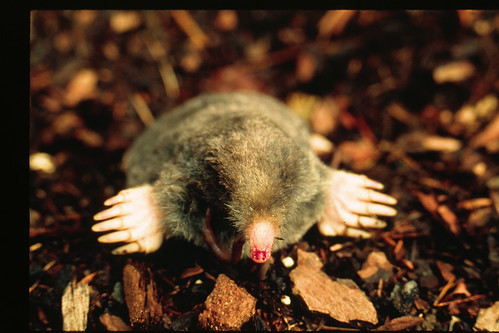
English: Coast Mole (Scapanus orarius) range (Photo credit: Wikipedia)
Coast Mole
Scapanus orarius
The Coast Mole is mole species often found in Idaho. It can also be seen most of the time in California, Oregon, Washington, British Columbia, and other states and islands in the Pacific Coast.
This species often likes hunt for food below the surface. The wildlife animal likes to forage for invertebrates, larvae, worms and mites. Studies suggest the mole may consume plants from time to time if there are no invertebrates. These moles try to avoid water areas and flood prone places, moving somewhere else far from the flood.
The mole have tiny non visible ears, small eyes and around forty four teeth. If you look closely, they have a narrow snout similar to other species. This snout is pink in color to light red in shade. They usually weigh 2.2 to 2.4 oz., with length of five to five and half inches. Their tail is somewhere between 1.50 to 1.70 inches.
The Coast Mole can reproduce at least one baby mole every year, which become an adult mole after nine months. The young adult wildlife mole would start leaving their mother's nest. They would then start finding their own range and territory.
They can dig either day or evening time. Their burrow tunnels can be deeper tunnels systems and surface tunnels. Both can be distinguished by the marks on the surface. The deep tunnels usually have nicely space mounds, while surface burrows have ridges on the soil.
Compared to other species, the mole's tail doesn't have hair, not even tuft. They usually have black coats, with the underside in their body a bit lighter in shade. They have slight longer claws, with wide feet. This species also have scoop like claws, which is similar to the Townsend Mole varieties.
Coast Mole (Photo credit: NWCouncil)
These moles are solitary in terms of their daily behavior. However, in breeding months after winter around February to March, they start seeking potential mates. The mother mole can have two to four baby moles, born after thirty two to thirty five days. The adult parent moles usually care for their litter young in deeper tunnel burrows under the ground.
The Coast Mole can adapt in what zoologist call 'fossorial existence'. Their physically and physiologically adapted to live underground for extended periods of time. From time to time the adult parent mole would go above the surface if there's not much food source in their tunnels. The young babies usually stay in the deep tunnel nest and are kept by the older moles to protect it from hawks and owls.
The Coast Moles build their burrow system, in turn also reproducing the mounds. These may happen to the surface because of the displaced earth dirt. This mole species don't usually use all their tunnels in their individual active cycle, as they would spend most of their tome near the main chamber with their nest. This is where the mole usually sleep after a hard day's work of digging tunnels and pushing mole hills. According to some studies, the Coast Mole can produce 500 to 600 molehills in a year. You can just imagine how many acres of lawns the Coast Mole can damage annually.
The Coast Mole can be under wildlife management from a wildlife company. It can be removed with lawn pest removal programs and mole trapping. You can contact a mole specialist for assistance on the mole trapper to use and where best to install the trap. Call a wildlife expert which are all licensed and experienced in wildlife removal.

